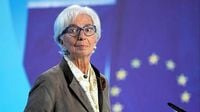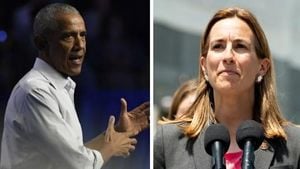The European Central Bank (ECB) delivered a widely anticipated decision this Thursday, opting to keep its key interest rate steady at 2% for the third consecutive meeting. The move, announced during a gathering in Florence, Italy, signals a cautious but confident stance by Europe’s top monetary policymakers as the continent’s economy navigates a maze of global trade tensions, persistent inflationary pressures, and modest growth.
ECB President Christine Lagarde struck an optimistic yet measured tone at the post-meeting press conference, telling reporters, “The economy has continued to grow despite the challenging global environment. However, the outlook is still uncertain, owing particularly to ongoing global trade disputes and geopolitical tensions.” According to CNBC, Lagarde emphasized, “From a monetary policy point of view, we are in a good place. Is it a fixed, good place? No. But we will do whatever is needed to make sure we stay in a good place.”
The ECB’s deposit rate, now at 2%, has not budged since June, when the central bank cut it from a record high of 4%. That reduction was part of a broader effort to rein in the double-digit inflation that swept Europe in the wake of the pandemic rebound and surging energy prices. By September 2025, inflation had cooled to 2.2%—just above the ECB’s stated 2% target—prompting many analysts to predict a period of stability in monetary policy.
“Inflation remains close to the 2% medium-term target and the Governing Council’s assessment of the inflation outlook is broadly unchanged,” the ECB stated in its official press release. The bank’s Governing Council reiterated its commitment to a “data-dependent and meeting-by-meeting approach,” refusing to pre-commit to any particular future rate path. As the press release put it, “The Governing Council is determined to ensure that inflation stabilises at its 2% target in the medium term.”
Despite the steady hand on interest rates, the ECB is acutely aware of the economic headwinds buffeting the continent. The eurozone economy grew by a modest 0.2% in the third quarter of 2025, according to preliminary data released Thursday. That figure was slightly better than many economists had forecast, and it leaves the economy 1.3% larger than it was a year ago. Still, growth remains fragile, particularly in major economies like Germany and Italy, which both posted zero growth in the third quarter after contracting in the previous one—narrowly avoiding the technical definition of recession.
Germany’s export-driven economy, in particular, has been hampered by a combination of factors: higher energy costs, fierce competition from China in sectors like autos and industrial machinery, a shortage of skilled labor, and what many business leaders describe as excessive bureaucracy. Italy, too, has struggled to gain momentum, with its own growth stalling after a small contraction earlier in the year.
One of the most significant external pressures has been the imposition of a 15% tariff by U.S. President Donald Trump on European goods. While many feared the tariffs would deal a crippling blow to European exporters, the impact has so far been less severe than anticipated. Recent business surveys point to a modest upswing in activity at the start of the fourth quarter, suggesting that European companies are adapting—at least for now—to the new trade landscape.
Lagarde acknowledged the “robust labour market, solid private sector balance sheets and the Governing Council’s past interest rate cuts” as important sources of resilience for the eurozone. She also noted that the services sector, buoyed by strong tourism and a surge in digital services, continues to grow. However, manufacturing remains under pressure from higher tariffs, economic uncertainty, and a stronger euro, which makes European exports less competitive abroad.
“The economy should benefit from consumers spending more as real incomes rise,” Lagarde told CNBC’s Annette Weisbach. Yet she cautioned that the divergence between external and internal demand is “likely to persist” in the near term, as the continent grapples with the aftershocks of the pandemic, shifting energy dynamics, and ongoing geopolitical uncertainty.
The ECB’s measured approach stands in contrast to the more aggressive posture of the U.S. Federal Reserve, which cut its own benchmark rate by a quarter percentage point just a day earlier and signaled the possibility of further cuts. Fed Chair Jerome Powell, however, was careful to note that another cut is not “a foregone conclusion.” The difference in approach reflects the unique challenges facing each side of the Atlantic: while U.S. inflation remains elevated, Europe’s inflation appears to be stabilizing, albeit at a slightly higher level than the ECB would prefer.
Market reaction to the ECB’s announcement was muted. The euro, which had gained ground earlier in the day, slipped 0.26% to $1.1571 after the decision, according to CNBC. Mike Coop, chief investment officer for EMEA at Morningstar Wealth, quipped, “What a boring announcement. It does belie the fact that inflation actually has gone back to being pretty much well behaved ... so it’s hardly surprising that they’re not feeling in a rush to change rates.”
Looking ahead, the ECB has made it clear that it will not be rushed into further changes. ECB Governing Council member Martin Kocher told CNBC, “At the moment, I think we’re in a good place. So, there’s no reason to change anything, as long as there are no changes that force us to do something.” Fellow Governing Council member François Villeroy de Galhau echoed this sentiment, advocating for “agile pragmatism” and reminding observers that “a good position is not a fixed position.”
Most economists polled by Reuters in mid-October expect the ECB to hold rates steady through the end of 2025 and possibly into 2026. The central bank’s own statement emphasized its readiness to “adjust all of its instruments within its mandate to ensure that inflation stabilises at its 2% target in the medium term and to preserve the smooth functioning of monetary policy transmission.” The ECB also highlighted the availability of its Transmission Protection Instrument, designed to counter unwarranted, disorderly market dynamics that could threaten the effectiveness of monetary policy across the euro area.
As Europe contends with the “triple shocks” of higher energy costs, less favorable trade terms with the U.S., and increased defense spending, the ECB’s steady hand is likely to be tested. The continent’s economic resilience will depend not only on sound monetary policy but also on broader reforms. Former ECB head Mario Draghi has called for sweeping changes to reduce bureaucracy and boost investment and innovation, warning that Europe faces increasing competition from China and must adapt quickly or risk falling behind.
For now, with inflation under control and growth—however modest—still in positive territory, the ECB is content to wait, watch, and act only when the data demand it. The message from Florence is clear: Europe’s central bankers are not complacent, but they are not panicking either. In a world of uncertainty, sometimes standing still is the boldest move of all.






